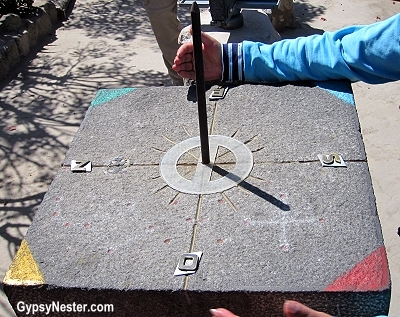
Just outside of Quito, Ecuador lies the exact midway point between the North and South poles and, being of reasonably sound minds, we had to see it.
Humans figured out around 500 BC that the Earth was a sphere and therefore must have a center line dividing the halves. In South America the ancient Quechua people named that equatorial line Inti (sun) Nan (path) centuries ago. Then in 1735, the French Geodesic Mission set out for Quito to pinpoint the location.

The expedition lasted nine years, was responsible for giving Ecuador its name, and succeeded in a fairly accurate measurement.
Although it turns out they probably should have just asked the natives, since modern GPS has proved that by simply observing the sun their line was more accurate than the French scientists.
Slight discrepancies notwithstanding, we knew we were within a few feet, if not inches, of that big blue stripe we’d seen on globes since grade school.
So bypassing the Mitad del Mundo complex and the old French monument, we chose The Intiñan Solar Museum and the “real” line.

But before we could get to the main attraction, we were sidetracked by a lesson on making shrunken heads… yes, they are real.
The Shuar people from high in The Andes of Ecuador performed this ritual, and now we know their secret… remove the skull, sew the eyes and mouth shut, then cook the skin for an hour or so and fill it with hot rocks.
All joking aside, this was serious business for the warriors, and obviously the victims too. Shuar feel that the muisak, or soul of the victim, is contained in the shrunken head (tsantsa).
Our guide, Alexandra, explained that because of this, head shrinking became all the rage with the nobility as well.

Okay, on to the line around the center of the world which, unlike on our classroom spheres, is red here.
Several sundial type instruments and markers are setup along the stripe to show how the sun passes perfectly overhead on the equinox, and always has an equal 12 hours of day and night year ’round.
Perfectly viable, accurate scientific stuff. Ah, but then came the “experiments.”
In order to demonstrate the Coriolis Effect, and our guide was very careful to specify that this was just a demonstration, a tub of water was sitting directly on the equator.
Now the Coriolis Effect is without a doubt perfectly real, it has to do with the earth’s rotation and the inertia effect it has on objects. It is what causes ocean currents, wind patterns, and hurricanes to rotate one direction in the northern hemisphere and the other in the south, but this “demonstration” had exactly nothing to do with it.

When the drain plug was pulled on the tub, the water ran straight out with no spin or vortex.
Perfect, there is no Coriolis Effect on the equator.
Then the tub was moved about six feet north of the line and water poured in, drain plug pulled, and viola, a vortex! Six feet south of the line, the vortex spins the opposite way.
Wow! We saw it with our own eyes!
But what really happened was just a “demonstration,” and our guide was quite subtle and sneaky with her technique.
The first tub was allowed to sit perfectly still long enough that the water was motionless and no vortex would form, while the others had just enough momentum left from the pouring motion to spin first one way, then the other.

The truth is, yes there is such a thing as the Coriolis Effect, but its effect is so miniscule this close to the equator that it could never be measured, much less move a tub of water. By the way, same thing holds true with toilets.
They spin whichever direction the flow of water pushes them, no matter which side of the equator you’re flushing on. Still, we appreciated the show.
We were then challenged to walk directly along the line with our eyes closed.
No explanation was offered as to why this should be more difficult directly on the equator than anywhere else, but we did have a hard time keeping our balance.
Personally I think that I’m just a klutz and can’t walk well with my eyes closed… but that’s just me.


Next came the balancing a raw egg on a nail trick, which is also supposed to demonstrate the lack of Coriolis Effect on the yolk directly on the equator.
This is also another thing that I can’t do, here or any place else on the planet I suppose.
If egg balancing is any easier at the equator than anywhere else in the world, the difference is so slight as to be nonexistent.
Bottom line, balancing an egg is difficult where ever you happen to be. Even our guide couldn’t pull it off… that said, Veronica did it!

It was so impressive that she was issued a certificate to commemorate the event. Our guide, Alexandra, made things official.


Veronica felt ever so proud of her accomplishment, especially when Alexandra stamped the back of her certificate with the much coveted “LATITUD 00, 00, 00” stamp.
The time had come for the goofy standing-in-both-hemispheres-at-once photos.
Has anyone ever come to this place and not done that?
Don’t think so.

BONUS TIME: More at The Intiñan Solar Museum



David & Veronica, GypsyNester.com
Click here to see our full adventure with Road Scholar – a not-for-profit organization – through Ecuador, Peru, The Galapagos Islands, Machu Picchu and much, much more!



Hey! I know this is kinda off topic nevertheless I’d
figured I’d ask. Would you be interested in trading
links or maybe guest writing a blog article or vice-versa?
My blog goes over a lot of the same subjects as yours and I believe we could greatly benefit from each other.
If you might be interested feel free to send me an email.
I look forward to hearing from you! Fantastic blog by the way!
Please email us at [email protected] to discuss this. Thanks.
Thanks-a-mundo for the blog.Really looking forward to read more. Awesome.
It’s also a matter of perspective I thought another tourist trap on the equator where they have two toilets back to back you flush one watch the rotation then moved to the other side of the two toilets flush it and it appears to spin the other way in reality they are identical toilets and they always flush in the same direction You’re simply standing on the other side of it in reference to the tank so it appears to spin the opposite direction in comparison to the other one
Nice post! Thank you.
Looks realy great! Thanks for the post.
Hello, i read your blog from time to time and i own a similar one and i was just curious if you get a lot of spam comments?
If so how do you prevent it, any plugin or anything you can advise?
I get so much lately it’s driving me crazy so any support
is very much appreciated.
We use Akismet Anti-Spam and it seems to work well.
I really can’t believe how great this site is. Keep up the good work. I’m going to tell all my friends about this place.
This is my first time pay a visit at here and i am really impressed to read all
at alone place.
Thanks very interesting blog!
Hi there! I simply wish to offer you a huge
thumbs up for your great info you have got right here
on this post. I am coming back to your website for more soon.
Am I missing something here? Doesn’t 0 degrees, 0′, 0″ go completely AROUND the entire Earth? Isn’t that what the “equator” is after all? How can one “spot” be 0.0.0 when any where along the equator is also 0.0.0? Sorry for sounding so dumb but I would really like to know how this is any different from any other spot along the equator? Thank you.
Correct, the entire equator is latitude 0.0 (north – south). The longitude (east – west) will change as you go around the globe.
Sorry to bust another myth, but the Sun follows the path of the Equator only twice a year. So the equal day and night thing will only apply twice a year on the corrosponding Equinoxes. 🙂
Even though you are correct about the path of the sun, the amount of daylight stays 12 hours each day year ’round on the equator.
http://curious.astro.cornell.edu/about-us/161-our-solar-system/the-earth/day-night-cycle/195-is-the-sun-always-up-for-exactly-12-hours-at-the-equator-beginner
I visited this site in May, I was very impressed with the tub of water experiment, the shrunken heads and the sun dials. It was a trip of a lifetime. I didn’t know till now though, the story behind the balancing egg demo. I also saw Cotopaxi on a clear day and did the Galapagos and the Ecuadorian Amazon. I’m saving your website in my favorites.
We went on to the Galapagos as well, one of our top memories. Didn’t make it to the Amazon though, hope to someday. Thanks for saving us and stop by anytime.
The real equator per GPS is in the middle of the road 405 feet north of their line. Check Google Earth.
Nooooooooo! Really?
I just love learning new things when I read travel blogs and I got a good education with this post. Interesting history and museum. I’ll pass on the shrunken heads lesson, however.
Thanks Cathy! Always glad to pass on interesting information.
Fabulously interesting. And, those shrunken heads! I must find out more about them. Great post with super pics.
Thanks Wanda!
Sounds like a bucket list experience!
Most certainly!
That was such an unusual story. When I read the shrunken head part… what??? Like in a cartoon. Very very interesting – all of it. Thank you!
It was pretty wild!
I love the history of the shrunken heads, never knew they removed the skull. That must have taken some fine handy work. I used to teach 6th grade and in CA, where I taught, 6th grade social studies was the study of ancient civilizations so we did a lot of work with mummification and I used to love grossing out my students when I described how they actually went about the process. And then we’d mummify game hens so they could see the drying out effect. Cool stuff.
Wow! Wish I got to do that in 6th grade.
Fascinating, I enjoyed the post and history
Thanks Noel!
It looks like you got a history lesson and learned a lot at the same time. I don’t know how long I could look at that shrunken head. Your photos are fantastic!
Very much so, thanks Michelle!
How amusing for humans to do these crazy stunts while the animals are thinking – yes, humans are crazier than us. Yup, they’re right.
I suppose they are right… at least sometimes. 😉
I traveled to the Southern Hemisphere for the first time this year. As a kid I always learned about the Coriolis Effect. One of the first things I did when I checked into my hotel was go flush the toilet to see which way the water would spin. When it didn’t go counterclockwise, I felt so embarrassed! Anyway, great post. It looks like you had a blast in Ecuador 🙂
Thanks Justine, we did have a blast, even if the toilets didn’t flush right. 😉
How interesting!! I never thought about what it would be like to be exactly on the Equator. I was fascinated that the water went straight down!!
I’ve driven past that museum – in a rush – so sorry after reading your post not to have stopped in. Looks super interesting.
It was! Pretty cool to stand in both hemispheres at once.
Pretty cool tour I especially like the trick with the water…always wondered about the whole toilet swirl thing.
Well I think that myth is busted Jane. 😉
We fly into Ecuador in September to spend a few months and we’re reading everything we can about this fascinating country. Your photos were great and the story about the shrunken heads was really interesting. I love collecting these kind of macabre factoids!
Thanks Anita, have a great trip!
Fun spot to visit. I hadn’t heard anything about balancing at the egg (myth or not) before.Love the picture in both hemispheres.
I envy you for having the time to enjoy that spot while you were in Quito! Our time was so limited (and filled with chocolate exploration!) that we didn’t have the time to get to that park. Looks like you had a great time. Thx for sharing.
Now you have a reason to go back Doreen. 😉
I’d be all over every one of these rites of passage. Thanks for putting them in my head for when we get there!
It’s pretty cool to stand on the equator, have fun when you get there Betsy!
I always wanted to know and see how they made shrunken heads! A bit macabre, I know, but curiosity is strong 😉 Thanks for sharing your experiences!
Our pleasure, as always. 🙂
Love the standing in two hemispheres pictures. I would be all over that cheesy photo opportunity.
How could anyone pass it up? ; )
I have my egg master certificate from there too 🙂
Did you frame it? 😉
I visited here and really enjoyed it as well. Interesting that the Coriolis Effect is so minimal. I also balanced the egg, mostly out of sheer determination though since my partner had done so and would never have let me live it down if I hadn’t done the same.
I know the feeling! But try as I may I just couldn’t do it.
-David
If you didn’t stand with one foot in each hemisphere I would suspect you of being an alien. We humans seem to have a fascination with borders. Growing up, my sisters and I used to “beep” whenever we drove across a bridge from one state to another, trying to capture that moment when the front seat people were in a different state than those in the back seat.
Even better than the four corners.
Your description of all of the fun things to do put this on my “must do” list of places to visit. Thanks!
The bucket list seems to keep growing.